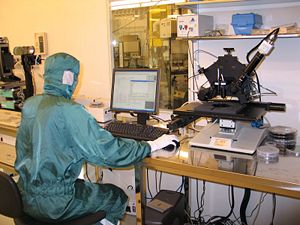Specific Process Knowledge/Characterization/Optical characterization: Difference between revisions
Appearance
| Line 1: | Line 1: | ||
==Ellipsometer== | ==Ellipsometer== | ||
==Filmtek 4000== | ==Filmtek 4000== | ||
[[image:Filmtek.JPG|300x300px|right|thumb|FilmTek: positioned in cleanroom 2]] | [[image:Filmtek.JPG|300x300px|right|thumb|FilmTek 4000: positioned in cleanroom 2]] | ||
<br clear="all" /> | <br clear="all" /> | ||
==A rough overview of the performance of the FilmTek and some process related parameters== | ==A rough overview of the performance of the FilmTek and some process related parameters== | ||
Revision as of 15:11, 13 December 2007
Ellipsometer
Filmtek 4000

| Purpose | Film thickness measurements and optical characterization of optically transparent thin films |
|
|---|---|---|
| Performance | Thin film materials that can be measured |
Any film that is transparent to the light in the given wavelength range ex:
|
| . | Film thickness range |
|
| Process parameter range | Wavelength range |
|
| Substrates | Batch size |
|
| . | Substrate material allowed |
|
Prism Coupler
Comparison of the three methods
See here: Film thickness and optical constants of optical transparent films
